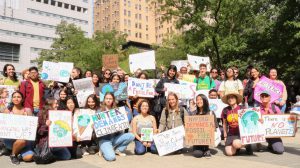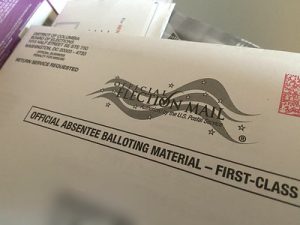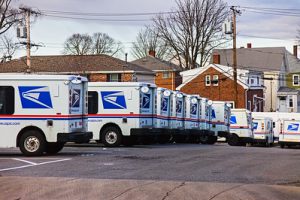Confronted with the new realities of online schooling, job loss and canceled milestone events young people are also dealing with the challenges COVID brings to the 2020 presidential election. “Young people are paying attention to politics, active in social movements, and acutely aware that the 2020 election will have an impact on their daily lives,” Center for Information and Research on Civic Learning and Engagement polls show.

One of the largest groups of socially and politically active students, the Hunter chapter of the New York Public Interest Group, center their efforts on issues that will directly affect students pre and post-graduation. Currently they are focused on the 2020 election, “I think I’ve sent 500 text messages in the past two days through this text platform we have about filling out the census and making sure people are registered to vote,” said Jack McAllister, Hunter senior and NYPIRG intern.
Not only are students tasked with choosing a candidate, but also which voting method will be most beneficial: by mail or in person. Voters will have to decide between the safety of voting from home, or the certainty of their vote counting at the booth.
The 2016 presidential election drew out 50% of eligible voters between the age of 18-29. More young people are registered to vote in at least 20 states now than were registered in November of the last election, according to the CIRCLE. The 2020 electorate projections show that Gen Z will comprise one-in-ten eligible voters, up 4% from 2016. Zoomers are also the most racially and ethnically diverse voting group.
“We have a really strong voice, and we’re one of the largest voting demographics in the country, ages 18-29, and we’re the least represented. But we’re the fastest-growing,” said McAllister.
With fewer poll workers and stations, it is easier for some to mail-in their ballot rather than vote in person. A reporter’s Instagram poll of 47 Hunter students found that 46.8% respondents were planning on voting in person, the rest by mail.

“I’m planning to do the mail-in ballot but then dropping it off at my polling place,” Kayla Mandernach, a Hunter College senior, said. “I live a block away from my polling place so I feel like it’s just the safest bet to make sure it gets there but also to not have to wait in line.”
Mandernach said Trump is using the pandemic to make it harder for people to vote. “It’s important to make sure my ballot gets cast because Trump is doing whatever he can to stay in the White House.” It is crucial to her that she uses the privilege she has to vote. “His administration has not done a good job at protecting black people, women, the environment and so many other things, and he just needs to be gone,” she said.
With concerning letters from the United States Postal Service warning 46 states, including D.C., of delayed ballots due to budget cuts, some are hesitant about the mail-in process. “Can’t trust the mail apparently. But will be voting early for sure,” said recent Hunter graduate, Barabara Sandoval.
In New York eligible voters have the option to vote early (in person), mail-in their ballots or vote in person on November 3. “I’m hoping that people vote early to sort of spread out the amount of people at a single polling site on November 3rd,” Sandoval said.

Even if voters adhere to the mail-in voting guidelines there is still a chance some may arrive too late to be counted. The USPS highly suggests requesting ballots as soon as possible, and sending it out at least 15 days prior to election day, preferably much sooner than that.
“I will be voting in person,” said McAllister. “I think with all the stuff you’re seeing in the media and social media about the potential challenges of a very big mail-in voting effort is that if you can and you’re not at a big risk to go out and vote in the traditional way, he said. “We’re at a real crossroads in 2020 where we need to be making decisions for 40, 50 years in the future and not the next four years.”
McAllister said empathy is at stake if people don’t vote this November. “Every issue that we have on the ballot could be handled a lot better with a little bit of empathy,” he said.
Early voting in New York runs from October 24 to November 1, and absentee ballots must be postmarked before October 9.

